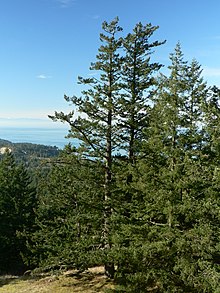
Back تنوب دوغلاس Arabic تنوب دوغلاس ARZ Yalançı tsuqa Azerbaijani Дугласія Byelorussian Дугласія BE-X-OLD Дугласка ела Bulgarian Pseudotsuga Catalan Pseudotsuga CEB Douglaska Czech Douglasgran Danish
| Pseudotsuga | |
|---|---|

| |
| Pseudotsuga menziesii var. menziesii in Anacortes Community Forest Lands, Washington | |
| Scientific classification | |
| Kingdom: | Plantae |
| Clade: | Tracheophytes |
| Clade: | Gymnospermae |
| Division: | Pinophyta |
| Class: | Pinopsida |
| Order: | Pinales |
| Family: | Pinaceae |
| Subfamily: | Laricoideae |
| Genus: | Pseudotsuga Carrière |
| Type species | |
| Pseudotsuga douglasii (Lindl.) Carrière
| |
| Species | |
|
See text | |
| Synonyms | |
| |
Pseudotsuga /ˌsjuːdoʊˈtsuːɡə/[1] is a genus of evergreen coniferous trees in the family Pinaceae (subfamily Laricoideae). Common names for species in the genus include Douglas fir, Douglas-fir, Douglas tree, Oregon pine and Bigcone spruce. Pseudotsuga menziesii (Douglas fir proper) is widespread in western North America and is an important source of timber. The number of species has long been debated, but two in western North America and two to four in eastern Asia are commonly acknowledged.[2][3]
Nineteenth-century botanists had problems in classifying Douglas firs, due to the species' similarity to various other conifers better known at the time; they have at times been classified in Pinus, Picea, Abies, Tsuga, and even Sequoia. Because of their distinctive cones, Douglas firs were finally placed in the new genus Pseudotsuga (meaning "false hemlock") by the French botanist Carrière in 1867. The genus name has also been hyphenated as Pseudo-tsuga.
- ^ Sunset Western Garden Book, 1995:606–607
- ^ "Flora of China: Pseudotsuga". Retrieved 17 January 2012.
- ^ "The Gymnosperm Database: Pseudotsuga". Retrieved 17 January 2012.
© MMXXIII Rich X Search. We shall prevail. All rights reserved. Rich X Search